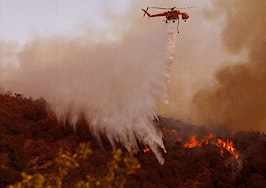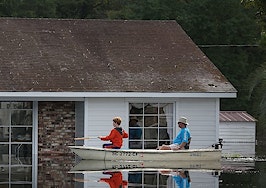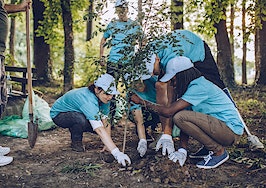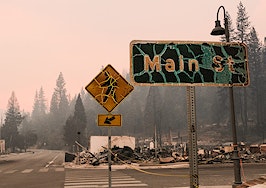Michael Keller grabbed his college degrees, a few mementos from his wedding and his computer. His wife grabbed a few things for their 3-year-old son. Then the family locked the doors of their home and drove into a maw of wildfire smoke.
Keller is the broker-owner of Keller Properties, an independent brokerage that serves the resort city of South Lake Tahoe. The community is the largest on the banks of Lake Tahoe, and has for decades been a magnet for people looking to escape — whether for a weekend or permanently — other parts of California, particularly the Bay Area.
On Monday, however, it was the residents of South Lake Tahoe who were looking to escape. That’s because the massive Caldor Fire was slowly bearing down on the community, prompting authorities to issue evacuation orders for thousands of people in the region.
The Caldor fire had burned more than 177,000 acres as of late Monday morning and was only 14 percent contained, according to state officials. It is currently the second largest active wildland blaze in California, after the Dixie Fire, and will ultimately end up being one of the largest 20 fires ever in recorded state history.
With South Lake Tahoe now in the fire’s path, the question is what happens in the near and long term to the community of sprawling lakefront estates, cozy second homes and tony vacation rentals.

Traffic backed up on Highway 50 as people evacuate ahead of the Caldor Fire Monday in South Lake Tahoe. Credit: Justin Sullivan and Getty Images
The lead up
The Caldor Fire erupted Aug. 14. The cause is still under investigation, but authorities do know that it has destroyed more than 400 structures and injured at least five people. Evacuation orders currently stretch across three counties in the region.
The fire has only recently begun to approach the community of South Lake Tahoe, but for weeks its smoke plumes have at times blanketed the region in a stifling haze. But there is something of a potential upside: There are now fewer people in harms way.
“The air quality has been so bad that most of our second home owners and tourists have already left,” Keller explained.
Keller said about 30 percent of the people in the community are traditionally full-time residents, though COVID-19 has likely increased that percentage. The median price of a home sits around $650,000, he added, while some lakefront properties can easily fetch millions.
People from across the world flock to Tahoe for both the lake and nearby skiing, among other things, but the area is particularly popular among well-paid technology workers from San Francisco. And in turn that helps drive up home prices in the region.
In recent days, even as the vacation crowd was shying away from Tahoe, the housing market was still moving. Keller said that he has been working on a deal over the last week, for example, and the fire has not deterred the client.
“The buyer just said, ‘I don’t think this is going to burn down,'” Keller recalled, adding a moment later that “up until a couple of days ago inspectors were working” in the community.

Bill Dietz
Bill Dietz, the president and principal broker for Tahoe Luxury Properties, described a similar situation.
“I was showing property yesterday to clients who are still very bullish on the area,” he told Inman Monday. “I haven’t seen any deals unravel as a result of the current fire situation and the concerns about what’s to come.”
Both Dietz and Keller emphasized that the community is struggling right now, and that numerous people are waiting to see if they’ll still have a home. The stress in their voices was audible while talking to Inman, and Dietz described what sounded like apocalyptic imagery.
“You have a very dim light and a very orange sun,” Dietz said of the scene in recent days. “It’s very unnerving.”
But it was also significant that at least over the last few days, the fire hasn’t completely driven everyone away.

A chairlift at Sierra-at Tahoe ski resort sits idle as the Caldor Fire moves through the area on Monday in Twin Bridges, California. Credit: Justin Sullivan and Getty Images
The crisis
Mike Wyatt is an agent with Sierra Sotheby’s International Realty. He lives in and works exclusively with the Tahoe Keys, a South Lake Tahoe marina neighborhood in which homes sit right on the water. Wyatt has hundred clients with homes in the community, and as the fire approached he started getting calls from those clients.

Mike Wyatt
“They wanted to know if they’re house is going to burn down,” Wyatt said. “I tell them I don’t think so.”
Wyatt — who like Keller had evacuated by the time he spoke to Inman — reasoned that the homes in the Tahoe Keys are likely the most protected because they’re closer to water and have fewer trees to burn. But overall, he described the situation in the community as “not good.”
“They’ve got spot fires in town,” he added.
In Keller’s case, he spoke to Inman while staying about 20 miles away from town. But he was also planning on moving further away in an attempt to find refuge from a fire that was racing quickly over the mountainous landscape.
“In theory, we should be safe where we are,” he said. “But this has evolved so quickly.”
Keller has also been talking to clients in recent days about what is happening, and what the future may hold. But at this point it’s mostly just a waiting game; South Lake Tahoe could emerge from the crisis fully unscathed, or in the worst case scenario it could be completely flattened. Everyone is hoping the latter doesn’t happen, but in the meantime all agents can do is hope for the best and stay in touch with their clients.

A snow machine blows water on a structure at Sierra-at Tahoe ski resort as the Caldor Fire moves through the area Monday. Credit: Justin Sullivan Getty Images
The future
All three of the agents who spoke with Inman for this story said they have roots in the region and don’t plan to abandon it after the Caldor Fire passes.
But it was also very unclear Monday what the future might hold. Keller, for example, said that he’s aware he may have to leave temporarily if worst comes to worst.
“We would absolutely stay,” he said, “but if the entire town is flattened, we would probably have to leave for an interim.”
And while Dietz hasn’t seen deals fall apart at this point, he did mention that some real estate consumers are “nervous about not just the fate of this particular fire today but also about what the future brings.”
Wyatt went further, saying that “I’m sure there will be a lot of people saying they want to get out of here.”
Such comments come amid a larger reckoning with life in the American West. A broad region spanning many states, the West gets slammed every year with massive wildfires that in some cases destroy entire communities. Smoke has become a near-constant part of summer life in certain regions, and the seven largest record fires in California history have all happened since 2018. Of the 20 largest fires in the state, only three burned before the 21st century.
Making matters worse, scientists have suggested events such as drought, heatwaves, and other conditions that make fires worse are likely only to become more extreme thanks to climate change.
The result has been an ongoing national conversation about the costs and benefits of living in parts of the West where wildfires are a constant part of life. And while the agents who spoke with Inman are ready to stick it out, their comments suggest that many consumers more generally are still waiting to come to their own conclusions.
Nevertheless, as the West generally grapples with these issues, South Lake Tahoe in particular may have some unique strengths. Dietz said the Caldor Fire may ultimately “shine a light on the things that need to be done” to make the community more resilient, and noted that despite some frayed nerves, the overall sentiment he sees from buyers is one of optimism.
“They said, ‘I feel very strong about the future of Tahoe. I wouldn’t hesitate to invest heavily in this area.'” Dietz said of his clients.
The area’s abundance of vacation homes and amenities may also help it bounce back more quickly than other rural regions if the fire does reach the community. For example, Dietz noted that many properties are second homes, meaning owners won’t necessarily be homeless if their houses burn, while Keller pointed to the Angora Fire in 2007, which destroyed hundreds of buildings in the area. Some of those buildings were never rebuilt, but most were and the community has become “a desirable area again at this point,” Keller said.
“With Tahoe, depending on how extreme this is,” Keller said, “I think we’ll maybe see it come back.”








